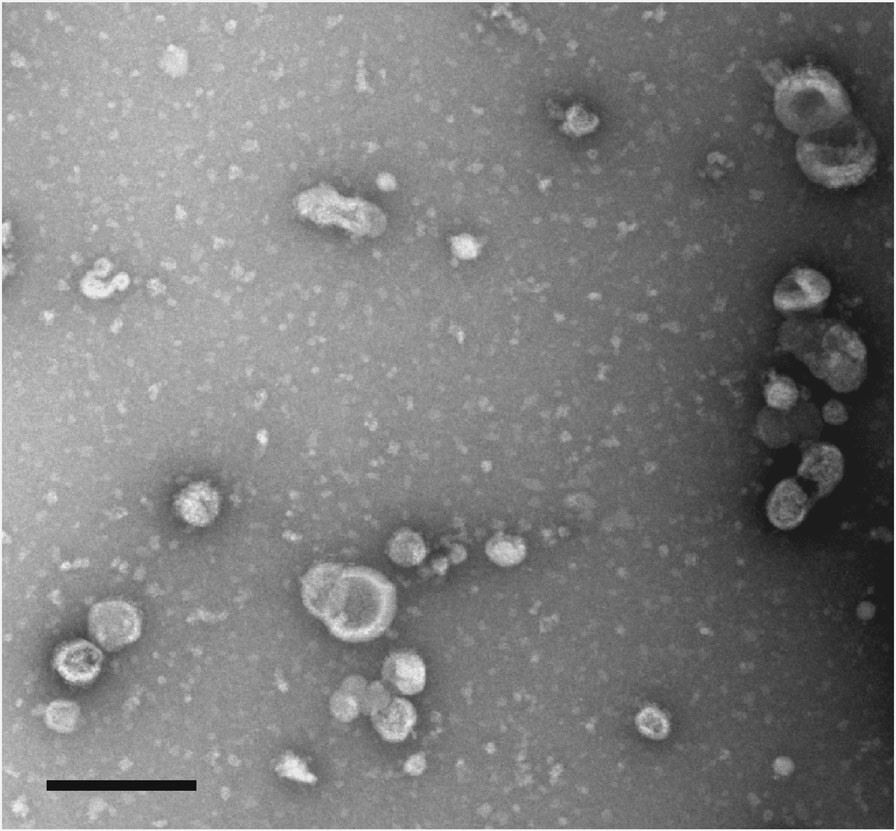Leishmania-derived Exosome Research and Application
Unlock the mysteries of Leishmania-derived exosomes through cutting-edge microbial exosome research services provided by Creative Biolabs. Dive into the nano-world of these potent vesicles, key to understanding and manipulating the complex relationship between parasite and host immune responses. Our state-of-the-art platform offers comprehensive solutions from isolation and characterization to functional analysis, providing you with tools to reveal the role of Leishmania-derived exosomes in immune modulation, disease progression, and potential therapeutic interventions.
Leishmania-derived Exosomes and Their Functions
Leishmania is a microbe that causes leishmaniasis, transmitted to humans and animals through sand flies. These parasites release exosomes, nanovesicles containing various proteins and RNAs capable of modulating the host's immune response and facilitating the infection process.
 Fig.1 Transmission electron microscopy of the secreted nanovesicles.1,2
Fig.1 Transmission electron microscopy of the secreted nanovesicles.1,2
Multiple studies have discovered that Leishmania-derived exosomes play a significant role in the interaction between this parasite and the host.
-
Immune Modulation: Leishmania exosomes can influence the host's immune response. They regulate the cytokine response of human monocytes by promoting the production of the anti-inflammatory factor IL-10 and inhibiting the production of the pro-inflammatory factor TNF-α. These exosomes can also alter the immune responses of dendritic cells and CD4+ T lymphocytes, thereby suppressing the host's immune system, creating favorable conditions for the parasite's survival and proliferation.
-
Promoting Early Infection: Studies indicate that these exosomes can enter the host cytoplasm by carrying effector proteins, such as GP63 and EF-1α, activate intracellular protein tyrosine phosphatases in the host cells, and disrupt the host's signaling pathways, thus creating a conducive environment for early infection. For instance, exosomes from Leishmania mexicana can inhibit the production of nitric oxide in infected macrophages, reducing their parasiticidal activity.
-
Pathogen Spread and Immune Evasion: The various pathogenic molecules contained in the exosomes, such as GP63 and PP2C, have a significant regulatory effect on the host immune response, helping the pathogen evade host immune surveillance. Exosomes can also affect the chemotactic behavior and cytokine expression of host cells, creating an environment conducive to early parasite infection.
-
Participation in Parasite Lifecycle: During different stages of the parasite's lifecycle, such as the procyclic and metacyclic-like stages, the proteomic composition of the exosomes can differ. These differences may affect their function in pathogen development and interaction between the pathogen and insect vectors.
Potential Prospects of Leishmania-derived Exosomes
Due to their critical role in host-pathogen interactions, Leishmania-derived exosomes show broad research and application potential.
-
Vaccine Development: Since exosomes can carry pathogen antigens and modulate immune responses, they could become vaccine candidates for preventing or treating leishmaniasis.
-
Novel Therapeutic Approaches: Explore the application of exosomes in drug delivery systems, utilizing their natural targeting abilities and capacity to evade immune surveillance, offering new strategies for treating leishmaniasis.
Creative Biolabs, as a leading biotech service company, we are dedicated to providing comprehensive exosome technology solutions. Our goal is to accelerate your research process and support your innovative results. If you are interested in our exosome technology services or have any questions, please feel free to contact us.
Microorganism-derived Exosome Isolation and Identification
In Vitro Functional Discovery of Microorganism-derived Exosomes
In Vivo Functional Discovery of Microorganism-derived Exosomes
References
-
Marshall, S.; et al. Extracellular release of virulence factor major surface protease via exosomes in Leishmania infantum promastigotes. Parasit Vectors. 2018, 11(1):355.
-
under Open Access license CC BY 4.0, without modification.
For Research Use Only. Cannot be used by patients.
Related Services:

 Fig.1 Transmission electron microscopy of the secreted nanovesicles.1,2
Fig.1 Transmission electron microscopy of the secreted nanovesicles.1,2








